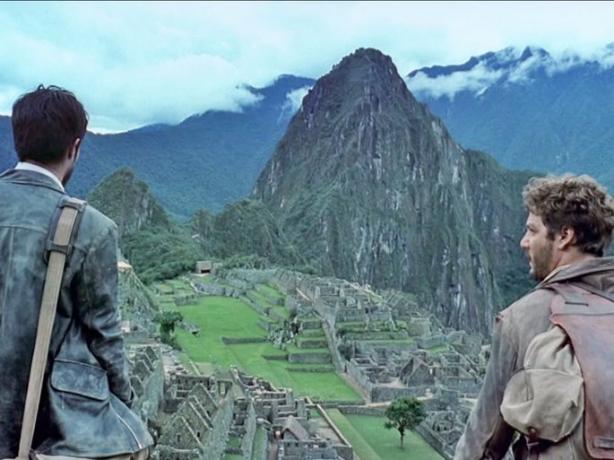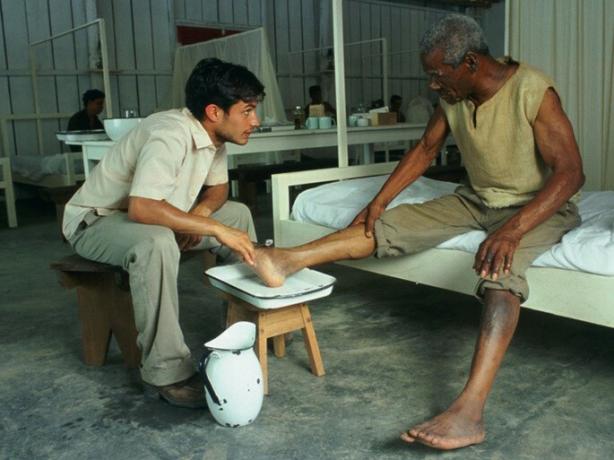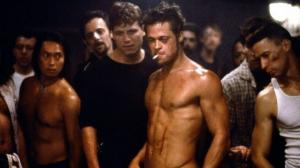The Motorcycle Diaries, by Walter Salles: summary and analysis of the film
Motorcycle Diaries is a Walter Salles film released in 2004. It is inspired by the book Travel notes, authorship of Che Guevara, written during his tour of several South American countries.
Through a motorcycle trip, the film discovers Ernesto Guevara before he became Che and addresses the transformation of a young aspiring doctor who opens his eyes to social injustices to later become a revolutionary man who would significantly influence the history of the century XX.
Summary of the movie

The film, which is contextualized in 1952 and based Travel diaries del Che, opens to the world a reflection on a double search for identity, on the one hand, that of the protagonist and, on the other hand, that of the Latin American continent.
Attention, from now on there may be spoilers!
Ernesto Guevara, a young medical student, embarks on a journey before finishing his studies with his friend Alberto Granado, a biochemist about to turn 30.
Both want to carry out a plan, travel 8000 km in four months with the aim of exploring with their own eyes and in an improvised way the Latin American continent, without paying attention to the old stories that the books tell about he.

The youngsters set out on their adventure from the city of Buenos Aires with an old Norton 500 motorcycle from 39, baptized with the name of "la Poderosa".
With the illusion of exploring a continent almost unknown to them, the adventurers set out from the Argentine capital to Patagonia. The plan of the trip is to head from there to Chile, and climb through the Andes to reach Machu Picchu. Once there, they would go to the San Pablo leper colony, then they would cross Colombia and culminate their trip in Venezuela, on Alberto's 30th anniversary.
His first stop is in Miramar and shortly after they continue the trip with different altercations due to the poor condition of the motorcycle, among them, different falls and the puncture of one of the wheels.
The idyllic excursion that the young people had planned soon turns into an ordeal due to the capricious incidents of the Mighty One. Meanwhile, the hikers delve into the American towns, discovering their people and their customs.

One day the motorcycle stops working, a fact that makes them wonder whether or not to continue with their route. However, they decide to advance on foot in a more liberated way.
In Chile, adventurers learn about the precariousness of forced labor when they talk to a couple who have been looted from their lands and who migrate in search of a better life for their children.
The mistreatment of the workers in the Chuquicamata mine, in Chile, also makes the protagonist reflect, who gets angry with the head of the miners for the treatment he gives his workers.
Upon his arrival in Peru, Alberto turns 30, however, fatigue prevents them from celebrating it.
It is in Machu Picchu, in front of the Inca ruins, where a kind of indignation arises in Ernesto about the development of the history of the American continent and makes you wonder what would have happened to that place if things had been different.

After their brief stay in Lima, Alberto and Ernesto visit leprosy patients in a leper colony in San Pablo. There they work as medical volunteers for three weeks without understanding the territorial division between workers and patients. The former are located on the north side of the Amazon River and the latter to the south.

During his stop at the hospital, Ernesto turns 24 and, completely transformed by what he experienced during those months, he dedicates a speech with which he asks those present to toast to "an America united ". He also wants to celebrate his anniversary with the sick and swims across the Amazon River, a fact that almost cost him his life due to his asthma attacks.
At the end of the trip, Alberto and Ernesto say goodbye at an airport, where they both reflect on the inequality and it is shown that Guevara is no longer the young man who left his house in the hope of discovering the world; he now he wants to transform it.
You can also read Machu Picchu: its architecture and meaning
Film analysis
The movement of people between countries and regions has always been present in the history of mankind. Wandering the world constantly forges the cultural and personal enrichment of the human species.
Throughout our lives we go through stages in which, imminently, we change the way we see the world around us.
This is what happened to Ernesto Guevara at the age of 24, before he became a legend, he underwent a process of transformation personal, an initiatory journey, in which he took as a starting point the knowledge of his roots across the continent Latin American.

Sociopolitical context: inequality and injustice
The film takes place in 1952, at the dawn of the Cold War and at the beginning of the expansion of communism throughout the Latin American continent.
Existing democratic systems are unstable. One of the main problems of the time lies in the disobedience of political leaders, who ignore the needs of a population that every day faces problems such as poverty, inequality and injustice Social.
The hero's journey in the form of roadmovie

In the purest style of adventure books, Ernesto and Alberto leave their city and become a kind of Don Quixote and Sancho from the 20th century, but this time with a Norton from 39, which far from the fidelity that Rucio and Rocinante show to their masters, forsakes them as soon as they start their walking.
For a story about routes there is nothing better than a roadmovie. That is why Walter Salles tries to capture in the cinema the book of Travel notes by Ernesto Guevara using a genre that perfectly describes the hero's journey, and that serves as a metaphor for the personal development that the young man experienced during the journey.
The director manages to move the viewer through this journey by making use of general shots, which are used to locate and present each of the stops, and also by panning and traveling, which provide the dynamic character of the film. Thanks to this, it manages to generate a sensation of constant movement during viewing.
The odyssey through linear discourse
The film is an emotional journey for the viewer. A route that has a beginning and an end that presents a linear order of the story, where the events unfold chronologically and in which there is no analepsis, that is, it lacks flashbacks.
Perhaps it is the presence of an intradiegetic narrator or protagonist, Ernesto, which allows Salles to reach the viewer more directly. The figure of a character-narrator who is present and participates in the story that he tells in voice in off. It is interesting to use letters addressed to his mother, who acts as narrator or recipient of the speech, so that the protagonist expresses his concerns throughout the trip.
Latin America as the protagonist
Although in the film we meet two main characters, Ernesto and Alberto, we could say that the continent itself also participates in a certain role. At the moment when Guevara exposes his concerns about a territory that is forcibly divided, we can say that he begins the search for the identity of the continent.
The Incas had a high knowledge of astronomy, medicine, mathematics among other things, but the Spanish invaders had the gunpowder. What would America be like today if things had been different?
This reflection that the character makes in front of the Inca ruins of Machu Picchu comes in the form of criticism. We can think about the cruelty of the human species, capable of destroying cultures and imposing others.
Multiple borders, one race
The director makes the film become a journey for the viewer thanks to the use of transcendental landscapes. More than 30 locations constitute a journey in the purest documentary style, through forests, plains, deserts, rivers and mountains.

With the landscapes of Latin America as a backdrop, Ernesto and Alberto witnessed the precariousness of the Amerindian peoples in which they knew first-hand the inequality between rich and poor.
That was one of the coldest nights of my life, but meeting them made me feel closer to the human species.
With these words from Guevara, in the middle of the Atacama desert, he closes one of the most moving scenes of the film. In it, the young people talk to a couple of farmers who were looted by a landowner and now go from place to place looking for work.
It is then that we know the two sides of the trip: the one that the protagonists do as leisure, moved by curiosity and that other form of travel, which involves the migratory movement of those seeking a life best.

Motorcycle Diaries it also makes us reflect on the meaning of the term “border”.
What is lost when crossing a border? Every moment seems split in two. Melancholy for what was left behind and on the other hand all the enthusiasm to enter new lands.
But in this case we see how the idea of "difference" between regions marked by Ernesto at the beginning, is blurred when he knows those "new lands".
Thus, we can consider that in this film the message is different. The border is still an imaginary limit, charged with political interest, which tries to divide “disparate” territories. This territorial separation contributes in part to the notion of belonging to a place.
Inspired by 1952 and shot at the beginning of the new century, the film makes us reflect on the dilemma of political borders in a world marked by constant migration crises, and it makes us think: should borders be above rights? humans?
The protagonists see the richness and diversity of landscapes in Latin America, but also discover that the cultural roots of the places they visit are the same.

In this way, at the end of the film, Guevara makes a speech that could be understood as a precursor of his revolutionary ideas.
The division of Latin America between uncertain and illusory nations is completely fictitious, we constitute a single mestizo race from Mexico to the Strait of Magellan.
The climax of the film is one of the most significant moments. In it, Ernesto reinforces the allegation reported above when he decides to cross the Amazon River to celebrate his 24th anniversary with leprosy patients, a fact that almost cost him his life due to his attacks asthma.
From that moment on we can conceive of Ernesto's transformation, ever closer to the legendary character that reigns in the collective imagination.
Ernesto before Che
Guevara was Ernesto before Che, or at least this is the version that Salles offers the viewer in the film.
It's funny how the director builds the character of Ernesto Guevara: he does it through actions and dialogues, but also through the environment that surrounds him.
Salles presents a generous, honest and sincere Ernesto, unlike Alberto Granado who is selfish and carefree. Thus, it is the antithesis of Granado's personality that reinforces Ernesto's kind character.
On the other hand, the film does not pretend to give a revolutionary vision but rather a transformative vision of the protagonist. This is achieved thanks to the use of an impartial look at what was the figure of Ernesto Guevara, for this the director makes us participants in the same inequalities and injustices that the characters experience in the first person. As spectators, it is impossible for us not to empathize with the situation on the continent.
Thus, if history has given us different versions of the figure of Che, Walter Salles prefers to show the person who existed before the myth and his transformation. It is only at the end of the film that he shows his revolutionary origin after completing his initiatory journey.
Soundtrack with Latin American roots
The soundtrack of Motorcycle Diaries it is a significant element along the route. Accompany the characters and the audience at all times and invite the total discovery of the Latin American identity.
The sounds of wind, string and percussion instruments, predominant in the continent, immediately transfer the viewer to the bowels of the place. Through sound we have the sensation of knowing in depth the landscape and its people.
Gustavo Santaolalla, Argentine composer and musician, sets the rhythm of this exciting journey and takes us, thanks to simple melodies, into each of the towns, offering a piece of his identity.
The incorporation of Santaolalla's compositions in the film is not something accidental, the producer offers the autochthonous character that recalls the route initiation that he did in the mid-eighties with the Argentine singer-songwriter León Gieco, in search of the origin of music through the natural environment in his draft From Ushuaia to La Quiaca.
Like the protagonists of Motorcycle DiariesThey also sought personal catharsis through an encounter with regional Latin American music, with sounds recorded directly in nature.
In the film the theme stands out From Ushuaia to La Quianca, an instrumental piece of a melancholic character. The song reminds us that music is the universal language, a simple melody with which it is almost impossible not to move to the landscapes and places of the film without getting emotional.
The soundtrack has a symbolic dimension that combines indigenous instruments such as the cajon with electric guitars. The journey between countries of the protagonists also becomes a musical journey through the traditional sounds of each place they visit.
For example, during his stop in Chile the Chipi Chipi, interpreted by María Esther Zamora and, later on, it also sounds How delicious the mambo.
The topic Across the river, composed by Jorge Drexler, reinforces the idea of “fighting against adversity” that awakens in Ernesto after his initiation journey and, above all, that of “not giving up”. Because there is always a light at the end of the tunnel that will guide us in the effort to solve injustices.
Drexler's composition, which won the 2005 Oscar for Best Original Song, is a reflection on itself.
Final assessment
The history of cinema has given us different films that talk about Che's life, but, unlike Motorcycle Diaries, most of them offer us the revolutionary face of the character.
Brazilian filmmaker Walter Salles brings a different point of view and allows the viewer to conclude that before Che there was an Ernesto that opened its eyes to the inequalities and injustices of a continent marked by an "identity wound" that did not end scar.
He also shows us that, above the protagonist, are the people of the Amerindian peoples.
The film is a journey with many stops along the way and reflects on a reality extrapolated to the present that manages to transform us all, even if only through screen.
Trailer
If you haven't seen the movie yet, you can watch the trailer here:



